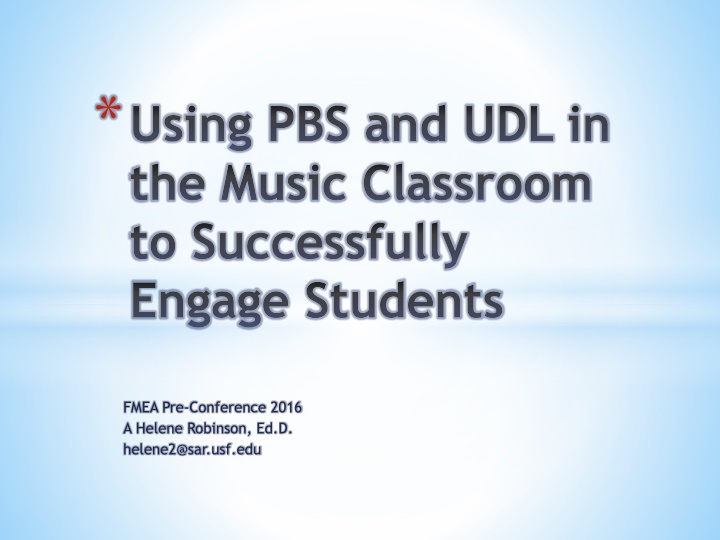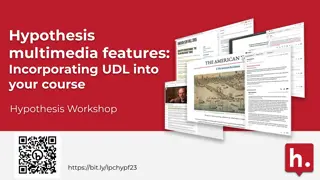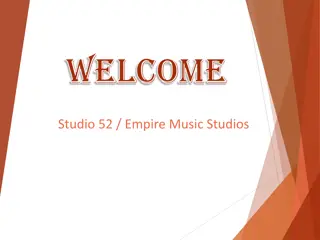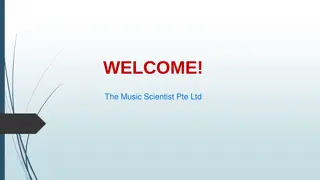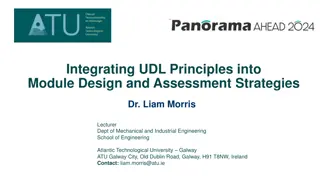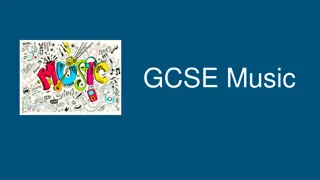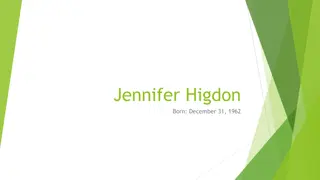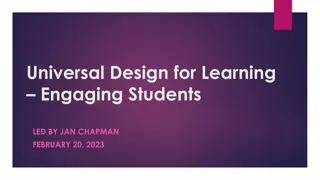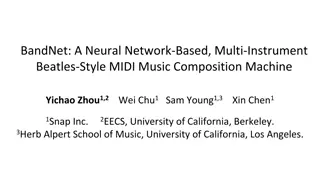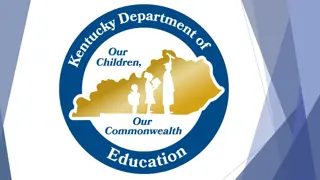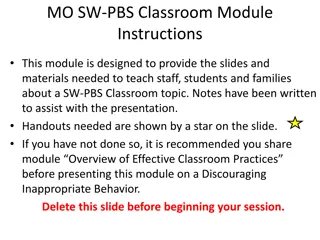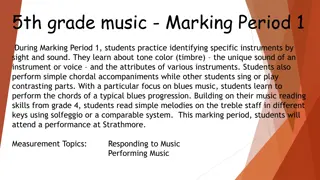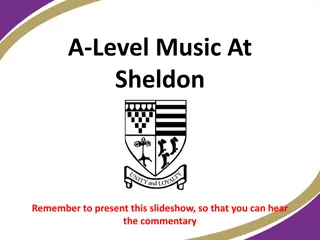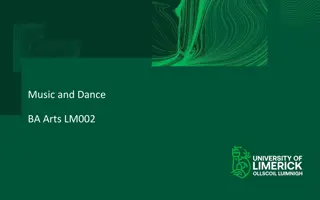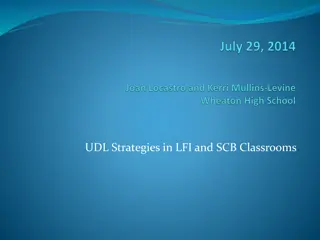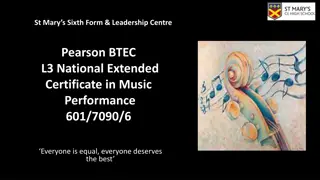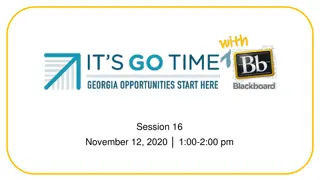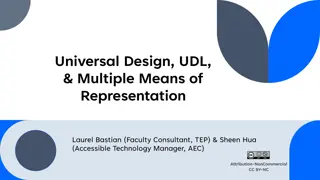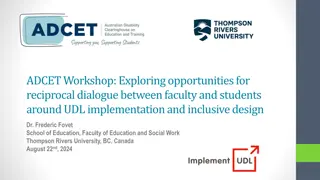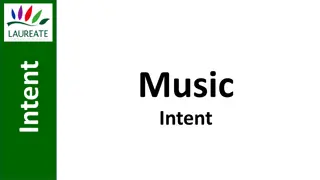Using PBS and UDL in Music Classroom to Engage Students
Implementing PBS and UDL strategies can help address barriers to learning, such as ADHD characteristics, in a music classroom. Explore how these approaches can support students like Sharon and Johnny who exhibit attention, organization, and impulse control challenges. Understand UDL guidelines to create inclusive and engaging music lessons.
Download Presentation

Please find below an Image/Link to download the presentation.
The content on the website is provided AS IS for your information and personal use only. It may not be sold, licensed, or shared on other websites without obtaining consent from the author.If you encounter any issues during the download, it is possible that the publisher has removed the file from their server.
You are allowed to download the files provided on this website for personal or commercial use, subject to the condition that they are used lawfully. All files are the property of their respective owners.
The content on the website is provided AS IS for your information and personal use only. It may not be sold, licensed, or shared on other websites without obtaining consent from the author.
E N D
Presentation Transcript
*Using PBS and UDL in the Music Classroom to Successfully Engage Students FMEA Pre-Conference 2016 A Helene Robinson, Ed.D. helene2@sar.usf.edu
*ADHD Characteristics: Inattention *Making careless mistakes *Having difficulty sustaining attention *Seeming not to listen *Failing to finish tasks *Having difficulty organizing *Avoiding tasks requiring sustained attention *Losing things *Becoming easily distracted *Being forgetful
*ADHD Characteristics: Hyperactivity *Fidgeting *Being unable to stay seated *Moving excessively (restless) *Having difficulty engaging quietly in leisure activities *Being on the go *Talking excessively
*ADHD Characteristics: Impulsivity *Blurting answers before questions are completed *Having difficulty awaiting turn *Interrupting/intruding upon others
Behavioral Inhibition *Affect ability to: *Withhold a planned response *Interrupt a response that has already been initiated *Protect an ongoing activity from distracting stimuli Executive Functions *Involve many self-directed behaviors: *Self-regulation *Working memory *Inner speech *Arousal levels *These common learning barriers can lead to social/emotional difficulties
Sharon Johnny * Having difficulty sustaining attention * Failing to finish tasks * Having difficulty organizing * Losing things * Becoming easily distracted * Being forgetful * Moving excessively (restless) * Being on the go * Talking excessively * Seeming not to listen * Having difficulty awaiting turn * Interrupting/intruding upon others * Avoiding tasks requiring sustained attention * Blurting answers before questions are completed * With a partner, select one of the students and write a case study on how this student would have barriers to learning in your music class.
*What are the UDL Guidelines? *Refer to handout or link: *C:\Users\helene2\Documents\PAINT center\UDL, Common Core, AI\UDL_Guidelines_v2%25200- Organizer_0.pdf *http://www.udlcenter.org/sites/udlcenter.org/fil es/updateguidelines2_0.pdf *Which guidelines when applied would best remove the barriers to learning you identified for your student with ADHD?
*What are the Principles of PBS? * Guiding Principle 1: Changing inappropriate student behavior requires changing teacher behavior. * Guiding Principle 2: Some students require more time, attention, and structure than others. * Guiding Principle 3: Students exhibit both desirable and undesirable behaviors for a reason. * Guiding Principle 4: Many behavior challenges reflect learning difficulties. * Guiding Principle 5: Most inappropriate behavior is predictably linked to specific contexts and activities. * Guiding Principle 6: It is more efficient and more effective to change student behavior by using positive strategies than punitive strategies. * Guiding Principle 7: It is more efficient and effective to use proactive, preventive strategies rather than relying on reactive strategies after a behavior problem has already developed. * Guiding Principle 8: Students benefit when general educators and special educators work collaboratively meet the needs of all students. * Guiding Principle 9: Students benefit when educators maintain close communication with parents to share information and collaboratively plan educational and home programs.
*A-B-C Model *Antecedents Behavior - Consequence *A Antecedents: Events that occur before behaviors and that may cue or set the stage for certain behaviors *Lack of clarity and predictability in expectations *Low levels of task engagement, unsuccessful academic performance, or lack of meaningful and dynamic instruction *Poor teacher-student relationship *Academic tasks *Instructions to do disliked or difficult tasks *Peer conflicts *Transitions *Low levels of structure *Exciting or highly stimulating activities *Emotions
*A-B-C Model *B Behavior: Behavior of concern * Deficits in academic skills * Deficits in self-control and self-management skills * Deficits in social skills * Deficits in communication skills *C Consequence: events that follow a behavior that determine whether the behavior will be repeated or not. * Consequences relate to functions of behavior. Common functions include: * To get something, such as attention, power and control, a preferred item, a preferred activity, a sensory experience * To avoid something, such as work, disliked situations or tasks, people, embarrassment, frustration, fear of failure, physical discomfort
DEFINING BEHAVIOR Behavior must be defined so that it is specific, making it observable and measurable. Give an example of at least one specific, observable, and measurable behavior that a child would demonstrate that is often incorrectly described with the term listed. Non-behavioral term Specific, Observable, Measurable Behavior Throws homework paper in the trash Responds I don t care to words of encouragement Walks away from group activity and makes comment, This is stupid . - - - Bad attitude Lazy ADHD Angry Disruptive Self-injurious Depressed Hyper Defiant
*Identifying the Function of Behavior Activity Group of volunteers to act out a scenario while audience observes and takes notes on the ABC s and then interviews teacher to gather more information. After reviewing observation notes and interview notes, decide with partner what you feel the function(s) of behavior was for the student. ..\EEX 4084\EEX 4070\ABC Chart.docx
A-B-C Chart Student s name: ______________________________________ Observed from ___/___/___ to ___/___/___ Completed by: ______________________________ Behavior of concern: (be specific and clear) ____________________________________________ Use this form at the beginning of an FBA to document what happens immediately before and after the behavior of concern. This can help discover what is triggering & reinforcing the behavior. Use for only one behavior (e.g. hitting). School/site: ________________ Date/Start & end time A=Antecedent: Location, activity, people, etc. B=Behavior What did the child do? C=Consequence What happened after the behavior Observer Initials
*How do I apply PBS? *Design effective intervention plans to modify antecedents for problem behaviors, teach new behaviors to better enable the person to manage those antecedents, and strategies to enable the person to access desirable consequences through appropriate behavior rather than inappropriate behavior.
*How do I Implement PBS? *1. Identify types of problems, replacement behaviors, noting behaviors with high priority. *2. Use a token system for positive reinforcement (not response cost) for group reinforcement of class expectations and individual reinforcement for replacement behaviors. Make class expectations general so that individual replacement behaviors can be related to a class expectation. *3. Use self-management techniques with visuals and graphs (self-instruction, self-monitoring, self-evaluation, and self-reinforcement) *4. Always implement from least restrictive to most restrictive using behavior reductive techniques: DRA, DRI, DRL, DRO; extinction with vicarious reinforcement; response cost; and types of time out (C:\Users\helene2\Documents\EEX 4084\EEX 4070\Using Time-Out Effectively in the Classroom.pptx
*Collaboration for Arts Integration and PBS *What is Arts Integration? *Why. . . ? *Students learn and remember better when they learn big ideas that connect different disciplines. *Students will generalize behavior into other settings when teachers collaborate using visuals so students can increase their self-regulation. *Students are motivated by the creative process: imagine/examine/perceive, explore/experiment/develop craft, create, reflect/access/revise, and share with others. *Findings show that arts integration and PBS, although effective with all students, are even more effective with diverse students.
